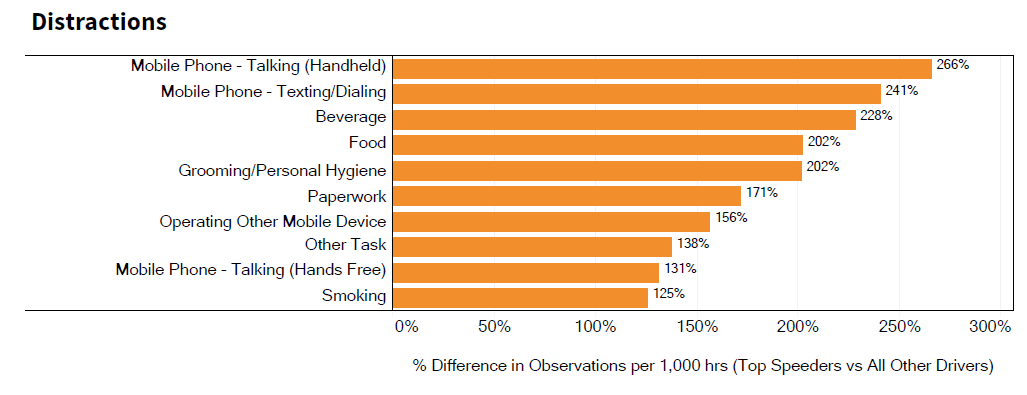
Now More Than Ever: Focus on Distracted Driving
We’re halfway through Distracted Driving Awareness Month and distractions continue to cause collisions on our roads.
A soon-to-be released SmartDrive SmartIQ® Beat reports that drivers who speed have a significantly higher propensity to be distracted while driving – more than 2.5x all other drivers. Not surprisingly, topping the list of distractions is mobile phones with food, beverage and grooming/personal hygiene not far behind.

How dangerous is distracted driving?*
- Distracted drivers are 36 percent more likely to be involved in a near collision than all other drivers. This number jumps dramatically—to 88 percent—for drivers distracted by a mobile device.
- Distracted drivers are 84 percent more likely than other drivers to roll through a stop sign or red light, and those distracted by a mobile device are 2.5x more likely to not stop – increasing the risk and severity of collisions.
- Overall, distracted drivers are 87 percent more likely to drive 10 mph or more over the speed limit, but if they are distracted by a mobile device, they are nearly 3x more likely than all other drivers to drive 10 mph or more over the speed limit.
- Distracted drivers drift out of their lane almost 2x more frequently than all other drivers. This number jumps to 2.3x more than all other drivers for those distracted by a mobile device.
- Drivers who are most often distracted are more likely to not wear their seatbelt at a rate of 4.1x higher than other drivers.
- Distracted drivers waste more fuel, resulting in 6 percent lower MPG than other drivers; this number increases to more than 8 percent when distracted by a mobile device.
Encourage your drivers to follow these Top 9 Tips to eliminate distracted driving in your fleet. If you tackle distractions, you will improve your safety results.
- Focus: Fully focus on driving. Do not let anything divert your attention, actively scan the road, use your mirrors and watch out for pedestrians and cyclists
- Emergencies: Use your cell phone for emergency situations only. Even hands-free devices can still cause you to miss important visual and audio cues needed to avoid a crash.
- Drowsy Driving: If you are drowsy, pull off the road. Drowsiness increases the risk of a crash by nearly four times. If you feel tired, get off the road; don’t try to get home faster.
- Multi-Tasking: Do your multi-tasking outside the truck. Focus on the road and the drivers around you. Get everything settled before you start driving.
- Storage: Store loose gear, possessions and other distractions that could roll around in the truck, so you do not feel tempted to reach for them on the floor or the seat.
- Adjustments: Make adjustments before you begin your trip. Decide on your route and check traffic conditions ahead of time.
- Dressing: Finish dressing and personal grooming at home – before you get on the road.
- Snacking: Snack smart. If possible, eat meals or snacks before or after your trip, not while driving. On the road, avoid messy foods that can be difficult to manage.
- Other Tasks: If another activity demands your attention, instead of trying to attempt it while driving, pull off the road and stop your vehicle in a safe place. Potentially dangerous distractions can last longer than most drivers expect.
Help your drivers understand the risks and make your fleet safer by printing this Distracted Driving Infographic and posting it throughout your facilities. By knowing that your driver has a habit of texting or talking on a cell phone, eating or drinking while driving, or engaging in other forms of distracted driving, you can bring it to his or her attention and coach on that specific behavior.
*SmartDrive SmartIQ® Beat Snapshot for Trucking, April 2017
- Posted by Melissa.Senoff@smartdrive.net
- On 15 April 2018